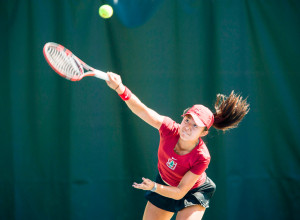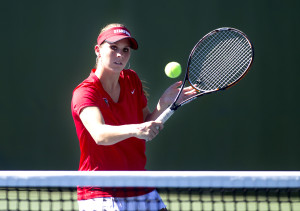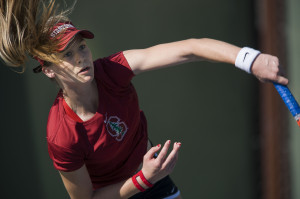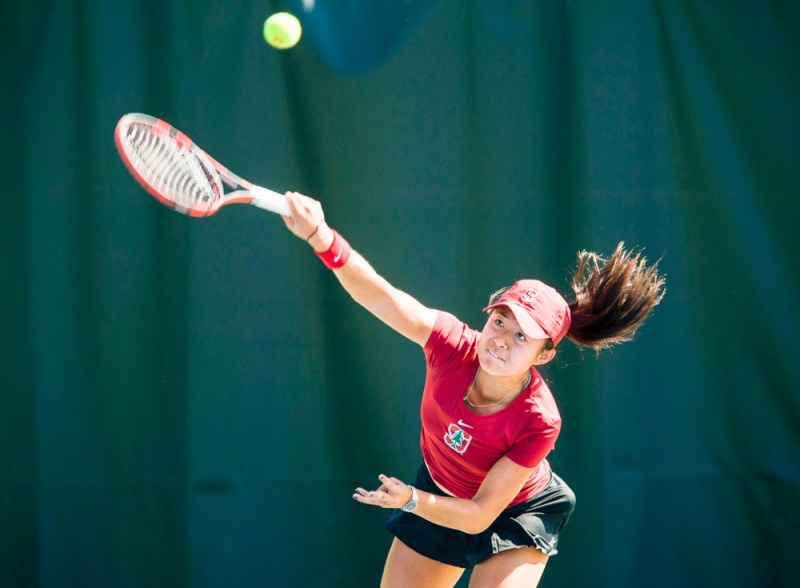When freshmen Taylor Davidson, Caroline Doyle and Carol Zhao arrived on the Farm for their recruiting trip over a year ago, they knew that Stanford and its storied women’s tennis program was the right place for them.
Of course, the prestige of playing for one of the country’s best tennis programs held an allure of its own, but beyond that, the three student-athletes found another reason for committing: each other. From the start, the three freshmen have had a strong dynamic and have helped each other traverse the difficulties of being a student-athlete at Stanford.

Given that Davidson, Doyle and Zhao now consist of half of the team’s lineup, are each ranked in the top-35 individually nationally and have combined to go 22-2 in singles dual matches this season, Stanford could not have asked for a better freshman class.
Davidson, Doyle and Zhao each come from very different places and backgrounds. Davidson hails from Statesville, N.C., where she would drive 50 minutes to and from practice every day in order to stay with her coach, who was based in Winston-Salem.
Doyle, who is from San Francisco, took a different route, playing in the Bay Area for years before beginning to train at the USTA Training Center in Boca Raton, Fla. She stayed there for two years, graduated high school in just three and joined the Cardinal along with two former opponents in Zhao and Davidson.
Zhao, who hails from Ontario, Canada — the team’s only international player — trained at Canada’s national tennis center for three years before coming to Stanford, all the while balancing rigorous academics and dedication to athletics, just like the other two freshmen.
Despite their disparate routes to Stanford, each of them became accustomed to similarly intense and individual tennis careers during high school. They all travelled widely, played at the highest levels of national competition and relied on only themselves to achieve success.
“It became a job, but it was a fun job,” Davidson said.
Yet playing for Stanford now, the student-athletes have been introduced to an entirely different team dynamic and paradigm of success.
“On the national team, we’d travel 20-25 weeks out of the year,” Zhao said. “[Going from] having to do that and deal with everything yourself to having a whole group of girls behind you, it’s a nice thing.”
“It’s really awesome being in an atmosphere where you’re training with the best, but they want what’s best for you equally as much as they want what’s best for themselves to create the best team,” echoed Doyle.
All three of them have enjoyed the feeling of team support from each other and their five non-freshman teammates. Given the college tennis format, strong team bonds and relationships are critical — a team only wins a match by earning four points, which are based off of singles match victories or earning the doubles point by winning two out of three doubles matches.

Total victory is a team effort, where no one point counts more or less than any other, but matches remain individual at their core, which can be an interesting balance to master.
“You can’t be looking at the scoreboard and thinking, ‘Oh, well if we have four matches that we’re going to win already, I can just give up and not try,’” Davidson said. “You still play for your team, but you’re still playing for yourself at the same time.”
Such a supportive environment has been key going into games, where the freshmen alone can earn three quarters of the points necessary for a team victory. Underlying this support is the added motivation to succeed for Stanford, where excellence has become an expectation for the women’s tennis team.
Head coach Lele Forood maintains the caliber by holding the team to a very high standard, but at the same time, the freshmen all describe the team as flexible and individualized to match each player’s needs.
Before big matches like the Cardinal’s recent 7-0 annihilation of perennial rival No. 2 Florida, the coaches help each player with specific skills she would like to polish, the team eats dinner together and they all stick to the same pre-match routine to establish a routine.
Through it all, Davidson, Doyle and Zhao also have had role models in the five older players on the team, especially seniors Amelia Herring and fifth-ranked Kristie Ahn. Even before their first matches of the season, the three freshmen understood the legacy to which they would be contributing.

“It’s pretty unreal going into this school, the reigning national champions, and more so, the most decorated tennis program in the country,” Doyle said. “Especially growing up in the Bay Area, I’ve always loved Stanford, so stepping onto the campus for the first time was just so amazing.”
The three all share the surreal feeling of having such a large role in a program that has won eighteen national championships — including last year’s, which maintained the university’s 37-year-long streak of winning at least one national championship.
There’s also a sense of respect from other schools that affects the team and is a new feeling for the three freshmen.
“If we play an away match, every single time we go somewhere, it’s that school’s biggest match” Davidson said. “It’s a cool feeling just being one of the top schools that people look at like that.”
Over the next three years, the freshmen will remain an integral part of the women’s tennis program, especially as leaders. The close relationships that they have established this year will only help their success in leading the team as a whole.
Despite the team’s low-key presence on a campus so dominated by football and basketball, the three are ready to do what it takes to win on their own terms, and to fulfill the high expectations they’ve set for themselves.
“For us, it’s not our goal to be the headline of everything,” Zhao said. “We need to do what we need to do to win matches, and that’s the most important thing.”
Contact Fiona Noonan at [email protected].
